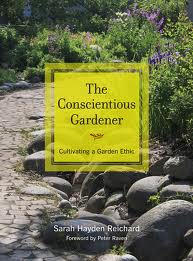 Sarah Reichard, the late Director of the University of Washington Botanic Gardens, is also the author of an important book for gardeners: The Conscientious Gardener: Cultivating a Garden Ethic. In reviewing this book, I must make a full disclosure–Sarah is also my new boss and someone I’ve known and worked with for many years.
Sarah Reichard, the late Director of the University of Washington Botanic Gardens, is also the author of an important book for gardeners: The Conscientious Gardener: Cultivating a Garden Ethic. In reviewing this book, I must make a full disclosure–Sarah is also my new boss and someone I’ve known and worked with for many years.
Reichard rightfully challenges gardeners to think outside of our individual gardens and see our role in the bigger system of both human endeavors and the natural world, and to see both the good and bad we can do. But she knows that being “good” isn’t easy! And being a long-time teacher, she uses a skillful blend of storytelling, humor, and breaking things down to easy steps to make her message understood but not overwhelming.
For example, in her chapter “Aliens among Us”, Reichard begins with the story of her concerns about introducing invasive plant species during a seed collecting trip early in her career. The scarcity of existing research led her to become a leader in the study of what makes plants invasive and the establishment and advocacy of guidelines for plant introductions in horticulture.
Recounting all this could be pretty heavy going, but she keeps it succinct and lightened with side boxes such as the role of the automobile (“Driving the Daisy”) in seed dispersion. Then, she both encourages, “Gardeners, take action!”, and tells how to do it, “Read on to plan your attack!” Like all chapters, this one ends with a set of Guidelines, very practical and doable steps each of us can take.
Excerpted from the Fall 2011 Arboretum Bulletin, by Brian Thompson.
Professor and UW Botanic Gardens director Sarah Reichard has her finger on the pulse of the planet in this erudite and accessible book. For those who have become complacent and fixed in their gardening ways, or for those just emerging as gardeners, there is much to learn in this handsome, information-rich volume. Are native plants always the preferred choice in our gardens? Do we really need soil amendments? Are we putting things on our lawns and landscapes that pollute nearby waters? What about those worms making compost in our worm bins: might they be invasive? Readers will discover that doing the right thing in our gardens is not only simpler than one might imagine, but deeply rewarding both personally and globally.
If you have been a persistent (but always polite!) thorn in the side of less conscientious (or simply unaware) gardeners and businesses who are purveyors of ivy and loosestrife, spreaders of weed-and-feed, and sprayers of pesticides, you will feel vindicated! If you have never spoken out before, you will feel inspired to do so! Reichard’s clearheaded call to action is well worth heeding.
Reviewed by Plant Answer Line librarian Rebecca Alexander, April 2011.
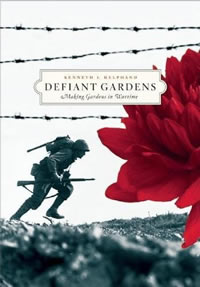 Defiant Gardens: Making Gardens in Wartime (2007) is not an easy book to read. The descriptions of the front lines, prison camps, Jewish ghettos, and Japanese internment camps from the first half of the 20th century are brutal, detailed, and very unsettling.
Defiant Gardens: Making Gardens in Wartime (2007) is not an easy book to read. The descriptions of the front lines, prison camps, Jewish ghettos, and Japanese internment camps from the first half of the 20th century are brutal, detailed, and very unsettling.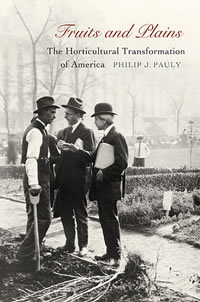 Philip Pauly was a professor of history at Rutgers University. His book, Fruits and Plains , was published by Harvard University Press. These are high academic credentials for a book that at first glance appears to be about gardening. But this is no ordinary gardening book. As suggested by the sub-title, The Horticultural Transformation of America, this is a serious study of the importance of horticulture to all aspects of American life particularly from the founding of the country well into the 20th century.
Philip Pauly was a professor of history at Rutgers University. His book, Fruits and Plains , was published by Harvard University Press. These are high academic credentials for a book that at first glance appears to be about gardening. But this is no ordinary gardening book. As suggested by the sub-title, The Horticultural Transformation of America, this is a serious study of the importance of horticulture to all aspects of American life particularly from the founding of the country well into the 20th century. Sir Joseph Dalton Hooker: Traveler and Plant Collector (2001) by Ray Desmond is a marvelous travelogue, masking as a biography. Our hero took two multi-year expeditions (to Antarctica, New Zealand, and Australia from 1839-1843; and to India and the Himalayas from 1847-1851) as well as shorter trips to Morocco, Palestine, and the United States.
Sir Joseph Dalton Hooker: Traveler and Plant Collector (2001) by Ray Desmond is a marvelous travelogue, masking as a biography. Our hero took two multi-year expeditions (to Antarctica, New Zealand, and Australia from 1839-1843; and to India and the Himalayas from 1847-1851) as well as shorter trips to Morocco, Palestine, and the United States. Cottonwood and the River of Time by Reinhard Stettler explores an unlikely topic, cottonwood trees and their kin including poplars and aspens. A retired University of Washington professor of forestry, the author writes an engaging natural history beginning with a single tree, an old matriarch near the Snoqualmie River. While eventually global in scope, many of the examples continue to be set in the Pacific Northwest.
Cottonwood and the River of Time by Reinhard Stettler explores an unlikely topic, cottonwood trees and their kin including poplars and aspens. A retired University of Washington professor of forestry, the author writes an engaging natural history beginning with a single tree, an old matriarch near the Snoqualmie River. While eventually global in scope, many of the examples continue to be set in the Pacific Northwest. Thru the lens: 50 years of the Japanese Garden is a nearly hour-long documentary on DVD that explores both the history and current activities in the garden. Several docents, gardeners, and supporters are interviewed. I found the in-depth presentation of the tea ceremony particularly interesting. This documentary has a limited availability, but can be viewed with headsets at the Miller Library.
Thru the lens: 50 years of the Japanese Garden is a nearly hour-long documentary on DVD that explores both the history and current activities in the garden. Several docents, gardeners, and supporters are interviewed. I found the in-depth presentation of the tea ceremony particularly interesting. This documentary has a limited availability, but can be viewed with headsets at the Miller Library.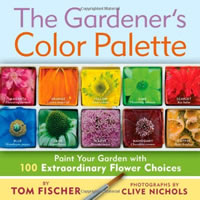 The Gardener’s Color Palette at first glance is a pretty book, but I was prepared to dismiss it as having little information of consequence. However, like with most books, it is important to read the author’s introduction. Tom Fischer’s second sentence summarizes his intent: “Flowers are nature’s most direct and accessible route to enjoying the pure pleasures of color.”
The Gardener’s Color Palette at first glance is a pretty book, but I was prepared to dismiss it as having little information of consequence. However, like with most books, it is important to read the author’s introduction. Tom Fischer’s second sentence summarizes his intent: “Flowers are nature’s most direct and accessible route to enjoying the pure pleasures of color.” David George Gordon wrote a delightful booklet (48 pages) in 1994 titled Field Guide to the Slug. After chuckling over the concept, I found there was a lot of information packed in those few pages.
David George Gordon wrote a delightful booklet (48 pages) in 1994 titled Field Guide to the Slug. After chuckling over the concept, I found there was a lot of information packed in those few pages. Sarah Reichard, the late Director of the University of Washington Botanic Gardens, is also the author of an important book for gardeners:
Sarah Reichard, the late Director of the University of Washington Botanic Gardens, is also the author of an important book for gardeners: 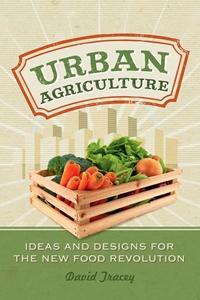 Though I personally am cheered by the sight of a P-Patch, a front garden, or a tiny apartment balcony resplendent with edible plants, there is still resistance to seeing raised beds replete with tomatoes and lettuce overtake a lawn or other underutilized space. Activist and arborist David Tracey’s
Though I personally am cheered by the sight of a P-Patch, a front garden, or a tiny apartment balcony resplendent with edible plants, there is still resistance to seeing raised beds replete with tomatoes and lettuce overtake a lawn or other underutilized space. Activist and arborist David Tracey’s